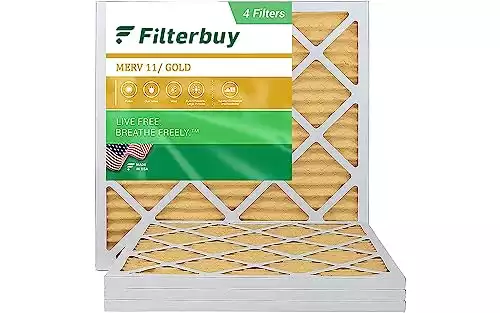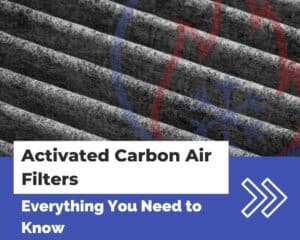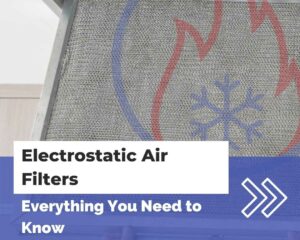HVAC Training Shop is reader-supported. As an Amazon Associate, I earn from qualifying purchases.
When browsing for air filters, you should just go for the filter with the highest MERV rating, right?
Not always.
Many people don’t consider how a filter with a high MERV rating will affect other parts of their HVAC system.
In this article, I’ll discuss whether higher MERV ratings affect airflow. I’ll also go over how air filter size and efficiency affect airflow.
Does a higher MERV rating affect airflow?
Generally, a filter with a higher MERV rating will reduce airflow. However, there are many other factors at play such as the size of the filter and the type of blower motor in your HVAC system.
Even if high MERV filters are used, will it substantially affect your system?
One study found that while there is a link between using high-efficiency filters and increased energy use, for most residential systems the impact is not significant.
When it comes to air filters affecting airflow, there are three factors at play:
How air filter size affects airflow
Assuming all else is equal, the larger the filter, the more airflow through your HVAC system.
This applies to both the length, width, as well as depth of the filter.
This is because a filter with a large face area will minimize pressure drop.
In a pleated filter, the deeper the filter, the longer the pleats. Longer pleats mean more surface area of the filter that is used for filtering. The area of the filter used for filtering is called the face area.
A filter with more face area is effectively a larger filter size. So this means that a filter with a higher face area will produce less pressure drop.
How air filter efficiency affects airflow
The air filter’s efficiency has an indirect impact on airflow. Generally, filters with higher MERV ratings have less airflow.
The pressure drop across an air filter will determine how negatively the filter affects airflow. Higher pressure drop = less airflow.
The Air Conditioning Contractors of America assumes that the pressure drop across a filter is 0.10 in. w.c. However, one study found that actual pressure drops in home installations were on average 0.28 in. w.c.
Even though stronger filters produce higher pressure drops, there are some ways that airflow can be maximized while using high MERV-rated filters.
In fact, even filters with high MERV ratings can be used in some systems with a minimal pressure drop. The trick is that the filter’s face area needs to be maximized in order to obtain the lowest filter pressure drop possible.
There are three different ways to maximize your air filter’s face area and get more airflow:
- Increase the length and width of the air filter
- Increase the depth of the air filter
- Increase the number of pleats in the air filter
Increase the size (length and width) of the air filter
Increasing the air filter size is one way to increase airflow through your HVAC system.
For instance, if the air filter slot is in your return register, you can increase the size of the return register to accommodate a larger filter.
Increase the depth of the air filter
A deeper air filter has longer pleats, and longer pleats will allow more airflow.
The air filter slot on your home’s HVAC system determines the depth of the air filter that you can use.
In order to use a deeper air filter, your air filter’s slot will need to be large enough to accommodate the filter.
For example, you might increase the size of your filter slot from 1″ to 2″ to accommodate a deeper air filter.
Increase the number of pleats in the air filter
The more pleats an air filter has, the more airflow it will have.
When looking for air filters, air filters with more pleats will allow for more airflow, all else being equal.
This means that if you compare two MERV 11 air filters against each other, the one that has more pleats will likely allow more airflow.
How different types of blower motors affect airflow
The type of blower that you have in your furnace or air conditioner will largely determine if there will be a reduction of airflow in the system.
When overcoming air filter restrictions PSC motors will maintain less airflow but use the same amount of energy, while ECMs will maintain the same airflow but use more energy.
How Permanent Split Capacitor (PSC) Motors affect airflow
Permanent split capacitor (PSC) motors are used in most standard, economy-priced furnaces.
In the presence of airflow restriction, PSC motors will consume relatively the same amount of power but provide less airflow.
Even though the amount of power that a PSC consumes remains unaffected, the reduction in airflow can cause an overall increase in energy use. This is due to increased runtimes from the reduction of heating/cooling capacity.
When using a high MERV filter, you will likely see a slight reduction in airflow when using a PSC motor. As the filter gets dirty and more airflow is restricted, the PSC motor will deliver even less airflow.
How Electrically Commutated Motors (ECMs) affect airflow
Electrically Commutated Motors (ECM) are newer and more energy-efficient than PSC motors. ECMs consists of a brushless DC motor combined with a microprocessor to control its speed.
The result is that when airflow restriction is introduced, the ECM will speed up to maintain the same amount of airflow. Doing so increases the energy use of an ECM.
However, ECMs are already very energy-efficient, so they will on average use less energy than a PSC, even with a dirty filter.
How Total External Static Pressure (TESP) affects airflow
The total external static pressure or TESP is the pressure difference across your entire HVAC system. The total external static pressure is measured by taking the difference of the pressure between the supply and return registers.
Why is TESP important? It is an indicator of how much airflow is going through your system. Generally, higher TESP = more airflow.
How do air filters contribute to total external static pressure?
Air filters contribute to TESP by reducing the total external static pressure in the system. This means that using an air filter will reduce the amount of airflow in your HVAC system.
Most residential homes are designed to have no less than 0.5 in. w.c. of TESP. Since the air filters in many residential homes contribute to more than half of that pressure, it is clear that air filters are responsible for a large part of the pressure drop in an HVAC system.
Since using an air filter is not optional, you’ll need to find a filter that meets both your air filtration needs and airflow requirements.
The diagram below shows a typical pressure distribution of a residential HVAC system:

In the diagram, the total external static pressure is represented by ΔPreturn and ΔPsupply. You can clearly see how the air filter reduces the total external static pressure by adding to the pressure drop.
Are MERV 11 air filters too restrictive?
MERV 11 air filters aren’t too restrictive for most systems, as long as you remember to change the filter regularly.
If you upgrade to a MERV 11 air filter from a lower-rated MERV filter, you will need to change the filter more often.
4-pack of MERV-11 filters. These filters are a good compromise between high filtration and maintaining airflow.
The impact of dirty air filters on airflow
When your air filter gets dirty, the pressure drop across the filter will increase and cause a reduction in airflow in your system.
Did you know that a dirty filter actually filters out more particles? The implications of having a dirty air filter are similar to using a high MERV filter. As the air filter clogs, it is able to trap smaller particles in its dirty membrane.
I recommend changing your air filters every 1-2 months to maintain peak performance and energy efficiency levels.





I have a ruud silhouette ii, model ugph-07eauer manufactured in 2004. I don’t have the manual and am unable to determine the maximum MERV rating my system can handle. Can you help?
Hi Dan,
The maximum MERV rating that your system can handle depends on many factors besides the model of your furnace. If you need a definite answer, I recommend getting an HVAC professional to take static pressure measurements in your system. From there, they can recommend air filters that are appropriate for your system.